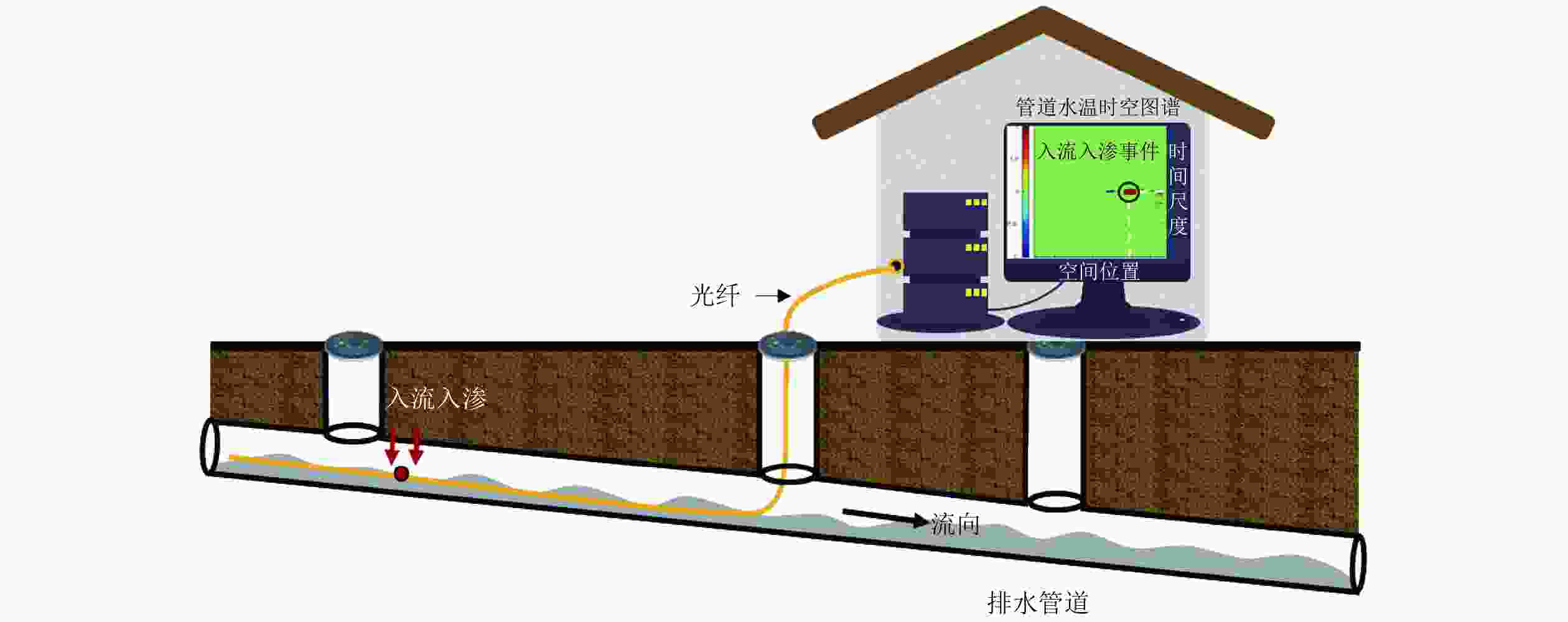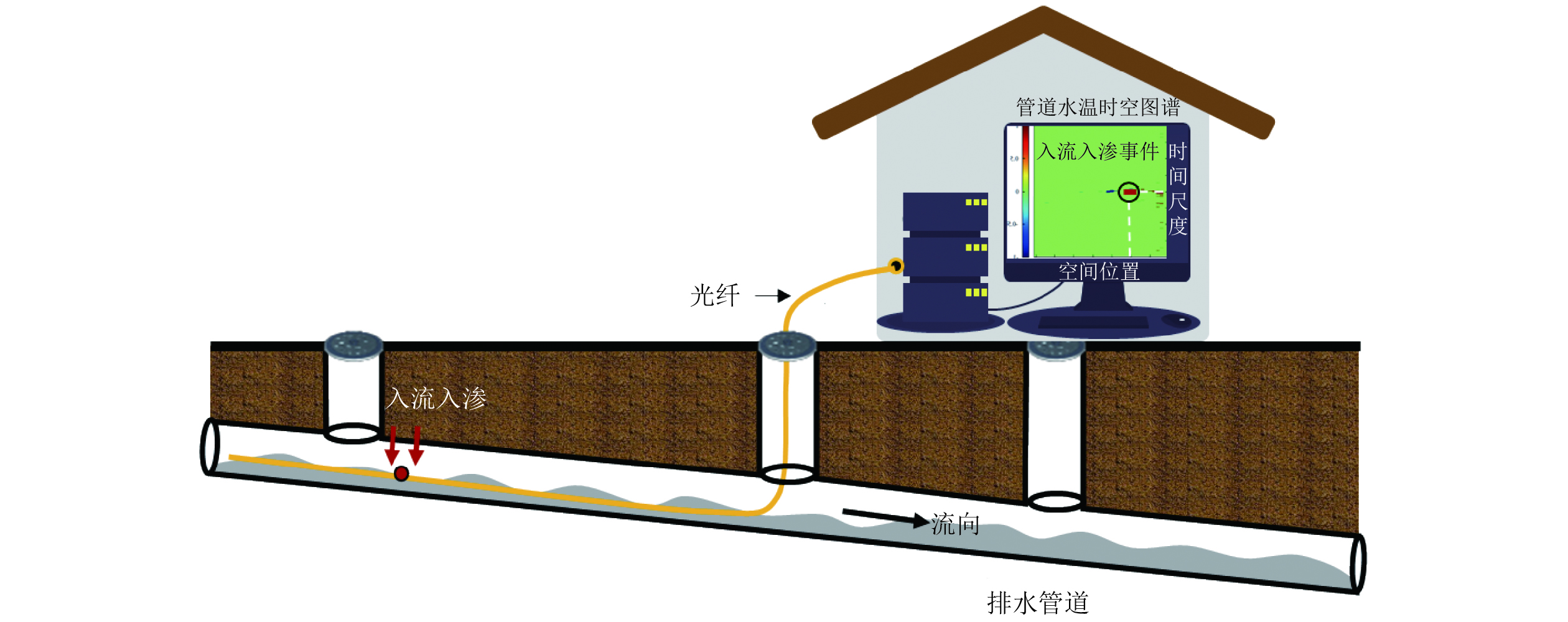Review on diagnostic technologies of illicit discharge and groundwater infiltration in the storm drainage network
-
摘要:
雨水管网是缓解城市内涝、改善水环境质量的重要市政基础设施,受管材老化腐蚀和施工过程不当等影响,我国城市雨水管网建成后普遍存在地下水入渗和污水混接问题,制约着雨水管网功能高效发挥。排水管网入流入渗诊断技术可为雨水管网混接入渗问题的识别和定位提供支持。综述了排水管网入流入渗诊断技术(物探检测技术、流量分析技术、特征因子分析技术、水动力反演模型技术)的基本原理、研究进展、应用特征等,对比分析了不同技术应用于雨水管网混接入渗诊断的适用性、实施要点、诊断水平和发展阶段等,并提出未来雨水管网混接入渗诊断技术的发展方向。结果表明:1)特征因子分析技术可在不干扰雨水管网正常运行条件下识别和量化混接入渗问题、提供治理优先级,因此经济和环境效益显著;2)光纤分布式测温(FDTS)技术和水动力模型反演技术在无干扰定位雨水管网混接入渗方面优势显著,前者易于实施且定位精准度高,后者具有成本低且可评级混接入渗等级特点,可根据场景特征因地制宜选用;3)未来雨水管网混接入渗诊断技术将朝着低成本、无干扰、可量化、可定位的方向发展。通过评估不同技术在当前和未来的综合应用效果,明确了单一诊断技术难以具备未来预期特征,而特征因子分析技术耦合FDTS技术或水动力模型反演技术的分级诊断体系具有实现未来技术发展目标的优势潜力。研究可为雨水管网混接入渗诊断技术的科学应用和优化创新提供参考。
Abstract:Stormwater network is an important municipal infrastructure to mitigate urban waterlogging and improve water environmental quality. Owing to the aging and corrosion, and improper construction of pipes, and so on, the urban stormwater network after construction in China often confronts the challenges of illicit discharge and groundwater infiltration, which restricts the efficient functioning of stormwater network. Technologies of diagnosing inflow and infiltration into drainage system can provide important support to identify and locate the illicit discharge and groundwater infiltration of stormwater network. The basic principles, research processes and applicable characteristics of the diagnostic technologies for inflow and infiltration into drainage networks (including geophysical detection, flow analysis, tracer parameter analysis, and hydrodynamic inversion model technologies) were reviewed, and then the practicalities, the key points of application, diagnostic levels, and development stages of these technologies were analyzed and compared. According to this, the future development trend of diagnostic technologies was proposed. The results showed that: 1) The tracer parameter analysis technology could identify and quantify the illicit discharge and groundwater infiltration without interfering with the normal operation of stormwater network, and provide retrofit priorities, resulting in significant economic and environmental benefits. 2) The fiber-optic distributed temperature sensing (FDTS) technology and hydrodynamic inversion model technology had outstanding advantages in non-interference locating of the illicit discharge and groundwater infiltration into stormwater network. The former was easy to implement and had high locating accuracy, while the latter had the characteristics of low cost and could be used to evaluate the levels of illicit discharge and groundwater infiltration. These two technologies could be selected according to local conditions. 3) The future development trend of diagnostic technology would be towards low-cost, non-interference, quantifiable, and locatable direction. By evaluating the comprehensive application effects of different technologies in the current and future, it was found that single diagnostic technology was difficult to possess the desired characteristics, while a hierarchical diagnostic system based on tracer parameter analysis technology coupled with FDTS technology or hydrodynamic inversion model technology had the advantage potential of achieving the future development goal. This study could provide references to carry out scientific application and optimization innovation of diagnostic technologies.
-
Key words:
- stormwater network /
- illicit discharge /
- groundwater infiltration /
- diagnostic technology
-
图 1 基于FDTS技术的排水管道入流入渗诊断示意[16]
Figure 1. Schematic diagram of diagnosing inflow and infiltration into sewers using FDTS technology
图 2 基于水量平衡分析的雨水管网混接入渗量化模型[10]
Figure 2. Quantitative model of illicit discharge and groundwater infiltration of stormwater network based on water balance analysis
图 4 基于特征因子和水动力反演模型的污水管网地下水入渗定位方法架构[13]
Figure 4. Architecture of pin-pointing groundwater infiltration into sewer network based on tracer parameters and hydrodynamic inversion model
表 1 不同来源类型水体的特征因子及其浓度分布范围[24,26-33]
Table 1. Tracer parameters of different water sources and their concentration distribution ranges
水源类别 总氮/
(mg/L)氨氮/
(mg/L)硬度/
(mg/L)硫酸盐/
(mg/L)氯化物/
(mg/L)氟化物/
(mg/L)钠离子/
(mg/L)钾离子/
(mg/L)安赛蜜/
(μg/L)咖啡因/
(μg/L)生活污水 25.0~80.2 59.2±12.6 138~241 0.26~0.43 45.7±8.8 1.1~51.2 10~46 灰水 4.3~13 0.58~4 138~185 37.9~58.9 57.8~82.5 0.26~0.36 45±10 24±7 1.07~1.78 240~1 300 黑水 35~267 20~148 179~241 179~241 159~232 0.31~0.43 39±12 38±8 27.9~51.2 地下水 1.0~9.4 4.3±6.7 383~449 50~150 90~156 0.15~0.70 55.2±0.0 8.22~25.64 0.016~0.023 0.01~0.14 水产品加工废水 798~1143 254~479 130~143 植物油加工废水 126~156 27.3~79.4 352~433 淀粉和糖制造废水 36.3~45.7 44.2~47.8 23.7~27.2 烘焙食品制造废水 456~776 414~514 476~532 豆制品加工废水 536~632 325~487 524~698 糖果/巧克力制造废水 34.1~45.3 34.5~42.3 4.4~8.3 2240~4220 乳制品制造废水 39.4~52.3 39.5~55.7 357~423 生物医药制造废水 5 087~7 006 3 013~5 864 2 065~4 013 半导体制造业废水 13.0~22.9 73.5~112.0 450~810 401~625 8.6~12.6 1.51~1.61 表 2 在同一点位连续监测的浓度型特征因子指标的CV[24,26,28,30]
Table 2. CV values of the concentration-type tracer parameters continuously monitored at the same sampling sites
水源类别 CV/% 总氮 安赛蜜 氟化物 硬度 柠檬酸 钠离子 氯化物 钾离子 硫酸盐 生活污水 15.9 58.3 25.0 14.8 灰水 15.0 10.3 6.5 20.1 30.0 10.9 28.0 14.6 黑水 16.4 7.9 7.4 68.3 24.4 11.5 19.9 16.1 半导体
工业废水14.4 2.1 13.3 11.6 30.1 16.0 水产品
加工废水20.0 8.9 3.0 植物油
加工废水26.8 7.1 5.8 膨化食品
制造废水6.7 18.4 3.4 糕点食品
制造废水17.9 9.1 11.1 豆制品
加工废水18.9 6.6 25.7 乳制品
制造废水10.9 8.7 5.7 方便食品
制造废水51.2 27.2 38.5 地下水 46.0 10.0 43.2 11.8 16.0 30.0 表 3 不同技术应用于雨水管网混接入渗诊断的特征、水平和发展阶段对比
Table 3. Comparison of the characteristics, levels, and development stages of different diagnostic technologies for illicit discharge and groundwater infiltration of stormwater network
诊断技术 适用场景要求 实施要点 成本 诊断精度 诊断
水平发展
阶段物探检测技术 CCTV技术 无需或易实施降水和清淤操作的雨水管道 降水和清淤 高 点位定位 定性 应用 红外成像技术 混接入渗引起的温度变化能在管道水体的自由水面体现;旁侧入流流量大于管道
流量的2.5%;管道水流流速波动较小保证红外成像设备漂浮安装
且稳定运行较高 点位定位 定性 研究 FDTS技术 混接入渗水体水量大且与管道原生
水体之间的温度差异显著保证光纤尽可能漂浮于水面上;避免光纤弯曲引起测量距离误差和
激光信号损失较高 点位定位 定性 小试 流量分析技术 水量平衡模型边界条件较少且应用场地
满足流量监测要求准确安装管道流量计;避免传感器被垃圾缠绕或被淤泥淤盖 高 区域定位 定量 应用 特征因子分析技术 不同来源类型水体的特征因子之间
存在显著性差异构建特征因子数据库 较低 区域定位 定量 中试 水动力反演模型技术 雨水管网水动力边界明确且物理
参数完整、准确精细化、精准化构建雨水管网水动力过程模拟系统 低 点位定位 定量 小试 注:技术发展阶段包括研究阶段、小试阶段、中试阶段、应用阶段、再突破阶段。 -
[1] 住房和城乡建设部. 2021年中国城市建设状况公报[A/OL]. http://www.chinajsb.cn/html/202210/11/29665.html. [2] XU Z X, XU J, YIN H L, et al. Urban river pollution control in developing countries[J]. Nature Sustainability,2019,2(3):158-160. doi: 10.1038/s41893-019-0249-7 [3] 徐祖信, 徐晋, 金伟, 等. 我国城市黑臭水体治理面临的挑战与机遇[J]. 给水排水,2019,55(3):1-5.XU Z X, XU J, JIN W, et al. Challenges and opportunities faced by urban black and odorous water treatment in China[J]. Water & Wastewater Engineering,2019,55(3):1-5. [4] 徐祖信, 张竞艺, 徐晋, 等. 城市排水系统提质增效关键技术研究: 以马鞍山市为例[J]. 环境工程技术学报,2022,12(2):348-355.XU Z X, ZHANG J Y, XU J, et al. Study on key technologies for improving quality and efficiency of urban drainage system: a case of Ma’anshan City[J]. Journal of Environmental Engineering Technology,2022,12(2):348-355. [5] 尹海龙, 王月, 赵刚. 分流制系统雨水管网混接旱天排放污染特征研究[J]. 环境科学学报,2019,39(10):3551-3558.YIN H L, WANG Y, ZHAO G. A study on characteristics of dry-weather discharge pollution from separate storm drains with inappropriate flow entries[J]. Acta Scientiae Circumstantiae,2019,39(10):3551-3558. [6] 陈唯, 肖涛, 李德师, 等. 基于检查井液位监测的雨污混接诊断方法[J]. 给水排水,2021,57(10):140-144.CHEN W, XIAO T, LI D S, et al. Investigation of illicit discharge based on manhole water level monitoring[J]. Water & Wastewater Engineering,2021,57(10):140-144. [7] WEISS G, BROMBACH H, HALLER B. Infiltration and inflow in combined sewer systems: long-term analysis[J]. Water Science and Technology:a Journal of the International Association on Water Pollution Research,2002,45(7):11-19. doi: 10.2166/wst.2002.0112 [8] MARTINEZ S E, ESCOLERO O, WOLF L. Total urban water cycle models in semiarid environments: quantitative scenario analysis at the area of San Luis Potosi, Mexico[J]. Water Resources Management,2011,25(1):239-263. doi: 10.1007/s11269-010-9697-6 [9] 中国工程建设标准化协会. 城镇排水管道混接调查及治理技术规程: T/CECS 758—2020[S]. 北京: 中国计划出版社, 2020. [10] XU Z X, YIN H L, LI H Z. Quantification of non-stormwater flow entries into storm drains using a water balance approach[J]. Science of the Total Environment,2014,487:381-388. doi: 10.1016/j.scitotenv.2014.04.035 [11] Environmental Protection Agency. Illicit discharge detection and elimination: a guidance manual for program development and technical assessments[S/OL]. Washington DC:US Environmental Protection Agency. (2004-08). https://nepis.epa.gov/Exe/ZyPDF.cgi/20017KFK.PDF?Dockey=20017KFK.PDF. [12] XU Z X, QU Y, WANG S Y, et al. Diagnosis of pipe illicit connections and damaged points in urban stormwater system using an inversed optimization model[J]. Journal of Cleaner Production,2021,292:126011. doi: 10.1016/j.jclepro.2021.126011 [13] ZHAO Z C, YIN H L, XU Z X, et al. Pin-pointing groundwater infiltration into urban sewers using chemical tracer in conjunction with physically based optimization model[J]. Water Research,2020,175:115689. doi: 10.1016/j.watres.2020.115689 [14] NIENHUIS J, de HAAN C, LANGEVELD J, et al. Assessment of detection limits of fiber-optic distributed temperature sensing for detection of illicit connections[J]. Water Science and Technology,2013,67(12):2712-2718. doi: 10.2166/wst.2013.176 [15] LEPOT M, MAKRIS K F, CLEMENS F H L R. Detection and quantification of lateral, illicit connections and infiltration in sewers with Infra-Red camera: conclusions after a wide experimental plan[J]. Water Research,2017,122:678-691. doi: 10.1016/j.watres.2017.06.030 [16] 尹海龙, 郭龙天, 胡意杨, 等. 基于光纤分布式测温的污水管道入流识别方法研究[J]. 中国环境科学,2022,42(4):1737-1744.YIN H L, GUO L T, HU Y Y, et al. A method on sewer inflow identification using fiber-optic distributed temperature sensing[J]. China Environmental Science,2022,42(4):1737-1744. [17] 郑洪标, 刘志国, 吴凡华, 等. 一种用于水上和淤泥行走的漂浮轮胎及管道机器人: CN210566983U[P]. 2020-05-19. [18] 覃新元, 雷宗辉, 陈俊, 等. 排水管道不停运的数字化服务成套技术实现和示范[J]. 中国给水排水,2023,39(2):94-99.QIN X Y, LEI Z H, CHEN J, et al. Complete set of digital service technology and demonstration for continuous operation of drainage pipelines[J]. China Water & Wastewater,2023,39(2):94-99. [19] 蔡兆祝. 基于两栖机器人的雨污管道自动化巡检技术研究[D]. 杭州: 浙江大学, 2021. [20] HOES O A C, SCHILPEROORT R P S, LUXEMBURG W M J, et al. Locating illicit connections in storm water sewers using fiber-optic distributed temperature sensing[J]. Water Research,2009,43(20):5187-5197. doi: 10.1016/j.watres.2009.08.020 [21] KESSILI A, VOLLERTSEN J, NIELSEN A H. Automated monitoring system for events detection in sewer network by distribution temperature sensing data measurement[J]. Water Science and Technology,2018,78(7):1499-1508. doi: 10.2166/wst.2018.425 [22] ALMEIDA M C, BRITO R S. System diagnostics using flow data: quantifying sources and opportunities for performance improvement[C]//Global Solutions for Urban Drainage. Lloyd Center Doubletree Hotel, Portland, Oregon, USA. Reston, VA: American Society of Civil Engineers, 2002: 1-13. [23] 肖涛. 排水管网系统运行状态诊断研究[D]. 上海: 同济大学, 2020. [24] 徐祖信, 汪玲玲, 尹海龙. 基于水质特征因子和Monte Carlo理论的雨水管网混接诊断方法[J]. 同济大学学报(自然科学版),2015,43(11):1715-1721.XU Z X, WANG L L, YIN H L. Quantification of non-storm water flow entries into storm drains using Monte Carlo based marker species approach[J]. Journal of Tongji University (Natural Science),2015,43(11):1715-1721. [25] 王诗婧. 基于截污效能提升的污水管网系统诊断与优化调控研究[D]. 上海: 同济大学, 2017. [26] YIN H L, XIE M, ZHANG L Y, et al. Identification of sewage markers to indicate sources of contamination: low cost options for misconnected non-stormwater source tracking in stormwater systems[J]. Science of the Total Environment,2019,648:125-134. doi: 10.1016/j.scitotenv.2018.07.448 [27] QUYEN D T T, MASAHIRO O, OTAKI Y, et al. Sewage markers as determinants to differentiate origins of emerging organic pollutants in an urban Sri Lankan water drainage network[J]. Water,2021,13(20):2898. doi: 10.3390/w13202898 [28] XU Z X, WANG L L, YIN H L, et al. Source apportionment of non-storm water entries into storm drains using marker species: modeling approach and verification[J]. Ecological Indicators,2016,61:546-557. doi: 10.1016/j.ecolind.2015.10.006 [29] 周骅, 智国铮. 基于三维荧光光谱和水质特征因子检测技术的排水管网地下水入渗分析研究[J]. 给水排水,2022,58(5):128-133.ZHOU H, ZHI G Z. Groundwater infiltration analysis of urban drainage networks based on 3D-EEM technology and marker species technology[J]. Water & Wastewater Engineering,2022,58(5):128-133. [30] 尹海龙, 郭龙天, 解铭, 等. 基于特征因子的食品工业废水排放追踪方法[J]. 同济大学学报(自然科学版),2019,47(8):1168-1174.YIN H L, GUO L T, XIE M, et al. Source tracking of food industry wastewater discharge into sewers using marker species[J]. Journal of Tongji University (Natural Science),2019,47(8):1168-1174. [31] 孟莹莹, 冯沧, 李田, 等. 不同混接程度分流制雨水系统旱流水量及污染负荷来源研究[J]. 环境科学,2009,30(12):3527-3533.MENG Y Y, FENG C, LI T, et al. Identifying dry-weather flow and pollution load sources of separate storm sewer systems with different degrees of illicit discharge[J]. Environmental Science,2009,30(12):3527-3533. [32] LITTON RACHEL M, HO A J, BRAM S, et al. Evaluation of chemical, molecular, and traditional markers of fecal contamination in an effluent dominated urban stream[J]. Environmental Science & Technology,2010,44(19):7369-7375. [33] TURNER R D R, ST J WARNE M, DAWES L A, et al. Greywater irrigation as a source of organic micro-pollutants to shallow groundwater and nearby surface water[J]. Science of the Total Environment,2019,669:570-578. doi: 10.1016/j.scitotenv.2019.03.073 [34] HOUHOU J, LARTIGES B S, FRANCE-LANORD C, et al. Isotopic tracing of clear water sources in an urban sewer: a combined water and dissolved sulfate stable isotope approach[J]. Water Research,2010,44(1):256-266. doi: 10.1016/j.watres.2009.09.024 [35] KRACHT O, GRESCH M, GUJER W. A stable isotope approach for the quantification of sewer infiltration[J]. Environmental Science & Technology,2007,41(16):5839-5845. [36] CHEN H, LIAO Z L, GU X Y, et al. Anthropogenic influences of paved runoff and sanitary sewage on the dissolved organic matter quality of wet weather overflows: an excitation–emission matrix parallel factor analysis assessment[J]. Environmental Science & Technology,2017,51(3):1157-1167. [37] LIAO Z L, ZHAO Z C, CHEN H, et al. Quantitative source apportionment of dissolved organic matters in wet weather overflows of storm drainage systems based on degradation potential index and end member mixing model[J]. Science of the Total Environment,2021,792:148493. doi: 10.1016/j.scitotenv.2021.148493 [38] GONSIOR M, ZWARTJES M, COOPER W J, et al. Molecular characterization of effluent organic matter identified by ultrahigh resolution mass spectrometry[J]. Water Research,2011,45(9):2943-2953. doi: 10.1016/j.watres.2011.03.016 [39] 朱弈, 叶建锋, 孙晓楠, 等. 基于溶解性有机物分子指纹特征解析城市河道污染来源与机制[J]. 环境科学,2023,44(8):4353-4363.ZHU Y, YE J F, SUN X N, et al. Analyzing the pollution sources and mechanisms of urban rivers based on identifying the molecular signature of dissolved organic matter[J]. Environmental Science,2023,44(8):4353-4363. [40] ROSSMAN L. Storm water management model reference manual volume Ⅱ-hydraulics[M]. Washington DC: US Environmental Protection Agency. (2017-08-07)[2018-04-17].https://nepis.epa.gov/Exe/ZyPDF.cgi?Dockey=P100S9AS.pdf. [41] 季骁楠. 城市市政排水管网污染物溯源技术研究进展[J]. 环境工程技术学报,2022,12(4):1153-1161.JI X N. Recent advances in pollution source identification technologies in municipal drainage pipe networks[J]. Journal of Environmental Engineering Technology,2022,12(4):1153-1161. ⊗ -





 下载:
下载:






